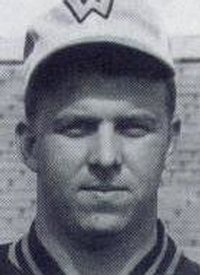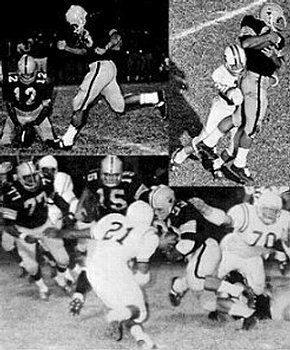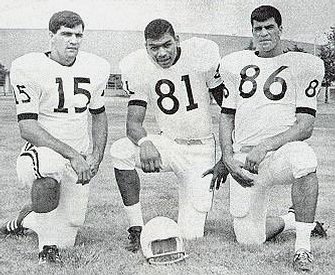If I didn't know the definitive location of either Ohio or
Cincinnati prior to leaving the New York City area for college, it was a
certainty that I had no idea where Wichita State University was. Always an
early riser, a typical Sunday during high school football season would have
been to awaken prior to sunrise and trudge downstairs to the basement to
lift weights, still an unusual and cult-like activity in the early '60's.
Without knowing it I was adhering to sound scientific and physiological
principles, training as soon as was reasonably possible after
Saturday's game and giving myself maximum recovery time prior to the
upcoming contest. Ignorant of science and its theories, long before the days
when lifting weights was an acceptable form of athletic preparation, and at
a time where "exercise science" did not yet exist, I trained when the
opportunity arose. I found that any soreness from Saturday's high school
game would abate sooner if I trained first thing on Sunday morning. Then, as
the sun was coming up, I would jump on my bicycle, and ignoring lower body
fatigue, pedal the mile or so to the nearest stores to buy Sunday bakery
products for my father and a copy of the New York Times. I should be clear
that no one in my family actually read the N.Y. Times or any other newspaper
nor did we see a newspaper in the house at any time, but I would rush home
on these mornings, lay the sports section of the Sunday Times out on the
floor, and immediately look through all of the college football scores from
the day before. The Sunday Times had the most complete section of scores
from all around the country, with only the teams from the Far West perhaps
left out as their games had ended too late to make the morning's
publication. I would see teams like Wichita State, Kent State, Abilene
Christian, and Drake and wonder where they were located, what type of
colleges these were, and who the players were that represented their
schools. In time, I figured out that Kent State was in Ohio and Abilene
Christian was in Texas from the location of their opponents. Wichita State
however, remained a mystery because I can recall that their opponents seemed
to come from many parts of the country. It was only after being at
Cincinnati that I discovered that Wichita State was located in Kansas, was a
member of the Missouri Valley Conference, and that they did indeed play a
wide-ranging, varied schedule and recruited their players as often from
Pennsylvania and New Jersey as they did from Kansas and Iowa.
Unfortunately, Wichita State's football history was
checkered and often dispirited. I knew that they had a great running back
who helped lead the Philadelphia Eagles to the NFL Championship in 1960 in
Ted Dean and I had seen Roland Lakes' name on the San Francisco 49er roster,
but there was little else about the program that was distinguishing. From
1960 through 1969 they changed head coaches on a regular basis, six times in
all, and this was a pattern that continued until football was terminated as
a varsity sport after the 1986 season. They rarely had stability and
recruited a lot of junior college players. They had a reputation of bringing
in many "outlaw" type players and at least in the mid-sixties, played a very
tough, aggressive brand of football. Upperclassmen noted that if nothing
else, the Wheatshockers always played tough and physically against us. In
the 1963 game, a 23-20 WSU victory for the 7-2 Shockers, end Bob Long and QB
Henry Schichtle played well enough to make the UC All Opponent Team, and
two-way back and receiver Miller Farr assured himself a number one draft
choice slot with the Denver Broncos based upon his All Conference play. They
also, and I'm sure, unknowingly to almost everyone who did not live in
Wichita, ranked second in the entire nation in total offense and sixth in
scoring. I knew Schichtle's name because he was a sixth round draft choice
of the hometown N.Y. Giants although his career comprised of but one game
appearance and he then put in time with the Waterbury (CT.) Orbits, the
Jet's farm team in the Atlantic Coast Football League. Long eventually made
it big with the Packers as a key receiver on their Super Bowl teams under
Vince Lombardi and then followed his coach to the Redskins in Lombardi's
brief time with them. Long made it even bigger as one of the first Pizza Hut
franchise owners which made him financially independent. He and a tackle at
Wichita State that also made the '63 UC All Opponent team received a
pizza-making education as they supplemented their football scholarships by
working in a pizza parlor near the Wichita State campus during their
undergraduate days. By the time we would be getting ready to play them, this
tackle was a Shocker assistant, coaching the line and walking their
sidelines although he too would make it a lot bigger in later years
considering that I am referring to Bill Parcells!
The 1964 game was payback as future Eagle DB Al Nelson,
HB Bill Bailey, and wingback Errol Prisby buried WSU under 328 yards of
rushing in a 19-7 win. Wichita stumbled from their 1963 tie with UC for the
Missouri Valley Conference Championship to a mediocre 4-6 record. The 4-6
slate included what was the toughest game of the season for National
Champion Arkansas.This varying level of performance was typical of Wichita
State, in part due to the many coaching changes and JC transfers they
regularly had; 3-7 in '62, 7-2 in 1963, 4-6 in '64, a drop to 2-7 in 1965;
2-8 in 1966; 2-7-1 in '67. They played great games and poor games. After the
1964 season, head coach Mecellino "Chelo" Huerta left to assume the same
post at Parsons College of Iowa and for '65, WSU named George Karras, the
former line coach at UMass as their new head coach. In addition to a very
young Bill Parcells another assistant coach was Gary Wyant. While perhaps
not a name well-known to the general public, Wyant went on to be a highly
respected assistant coach at the University Of Tennessee and then moved up
to a position as an executive administrator who served the Volunteer
athletic department for many productive years. Despite the end-of-year
record they had a few terrific players. Naturally, I checked out their list
of fullbacks but already knew that All Missouri Valley Conference performer
Pete DiDonato, a 5'10", 195 block of muscle was their primary ball carrier
and a good receiver. If you can look at a running back during warm-ups and
know he is a good player, DiDonato was that guy. I was surprised that he
never made it in the NFL after signing with the Broncos but he played two
years for a poor Wilmington Clippers team in the Atlantic Coast Football
League. Their other first team All Conference player was center and
linebacker Jim Waskiewicz, a big-for-the-day 6'4", 240 pounder who hit like
a bulldozer and gave our guys fits. When he showed up on the Jets for 1967
and then part of the 1968 season, filling in on both sides of the ball as a
center, tackle, and linebacker, I wasn't surprised. The QB who had taken
over for Schichtle was a Brooklyn guy named Lou Confessori who threw very
well and who later rostered with the Redskins and then played in Canada with
Winnipeg. Don Cherry was also an effective runner against us. Some of us
noted a really big tackle who wasn't listed in the program as a starter but
who played all game and was a defensive standout. At 6'7", you couldn't miss
number 73, Earl Edwards, who developed into a great college player by the
end of his career and then went on to play eleven years in the NFL primarily
with the 49ers and Bills. Edwards, out of Florida played a solid, effective
game and was another of our All Opponents as was DB Howard Starks. UC
triumphed 14-6 indicating that this two-win team was actually quite tough to
go against. It was a bit easier in '66 as the Shockers again finished with
only two wins and Cincinnati won 20-6. However, in typical Shocker fashion,
their two-victory team led the nation in passing offense behind QB John
Eckman and receiver Glen Meltzer. The 1966 team also had an All MVC
defensive end in tall, lean Jimmie Jones who spent time with the Jets and
then a few seasons with the Redskins.
Things that stood out when looking at the Shockers,
reading the game program, and then watching the films was that unlike a lot
of opponents that were on the UC schedule, they did not have a lot of home
grown talent and seemed to have a lot of excellent players mixed with a
number of less disciplined athletes. I believe they had fewer than ten
players from the state of Kansas and perhaps a few more from neighboring
Nebraska, Oklahoma, and Iowa. Most of their players were from Pennsylvania
and Florida, the effect I'm sure, of having so many junior college
transfers. Their uniforms were distinctive in part due to the great color
combination of black and gold/yellow and I always believed that the constant
coaching merry-go-round allowed each successive head man to try to design a
more memorable and exciting uniform for the players to keep enthusiasm high.
Karras was gone prior to my college graduation and the Shockers brought in
Boyd Converse for '67 who had won the National Junior College Championship
as head coach at Kilgore, Texas JC but after he and his staff were placed on
probation for recruiting violations that first season, a staff that included
future Oklahoma State, Miami, Dallas Cowboy, and Dolphin head coach Jimmy
Johnson and long-time Switzer and Dallas Cowboy assistant and administrator
Larry Lacewell, his one year run was terminated and former Wichita State
star Eddie Kriwiel was named as head coach. Continuing in their usual
fashion, Kriwiel's one year 0-10 record led to his release and the '69
hiring of Ben Wilson to close the decade.
The 1965 helmets were a Green Bay gold with a black center
stripe flanked by white stripes and a black oval type of logo on each side
that had what I recall as a white "W" within it. In 1966, the helmet shell
was changed to a bright shade of gold with a black oval containing a gold
"W" on each side. The black jerseys were very cool-looking with a Green Bay
type of gold and white sleeve stripe design and large gold numbers at home.
In '66 a white outline was added around each gold number that gave the
entire uniform a terrific appearance.The away jersey, worn in '65 at Nippert
Stadium in Cincinnati, was a simple white jersey with black numbers and
sleeve trim, a typical look for the era.
Unfortunately, the Wheatshocker program suffered an
unspeakable tragedy on October 2, 1970 as one of the two airplanes carrying
the team to a game in Logan, Utah against Utah State crashed into the side
of a mountain near Silver Plume, Colorado. Head Coach Ben Wilson and
fourteen players were among the twenty-eight passengers and three crew
members who were killed in a horrific crash that a careful reading of the
Federal accident report indicates was completely avoidable and due to human
error. Thanks to Jamie and Kelli for the above photo. While the October 17th game against Cincinnati was re-scheduled and
played on October 31st, the team, program, and school first battled back and
returned to the field against ninth-ranked Arkansas at Little Rock on
October 24th under the leadership of former assistant coach Bob Seaman. The
patchwork team of crash survivors, previously redshirted players, and
freshman lost 62-0 but played out their "second season" and gained the
admiration of the entire nation. Not as publicized as the Marshall
University football team plane crash that followed only five weeks later on
November 14, 1970 in which seventy-five people perished, many felt that the
Wichita State football program's demise began with this singular tragic
event. Never quite a "big time" program and yet consistently producing CFL
and NFL players, the Shockers remained in a netherworld of name-recognition,
scheduling problems, and financial viability. At the conclusion of the 1986
season, awash in a sea of red ink with little hope to field a profitable
football program, Wichita State University abandoned football after ninety
years of competition.





